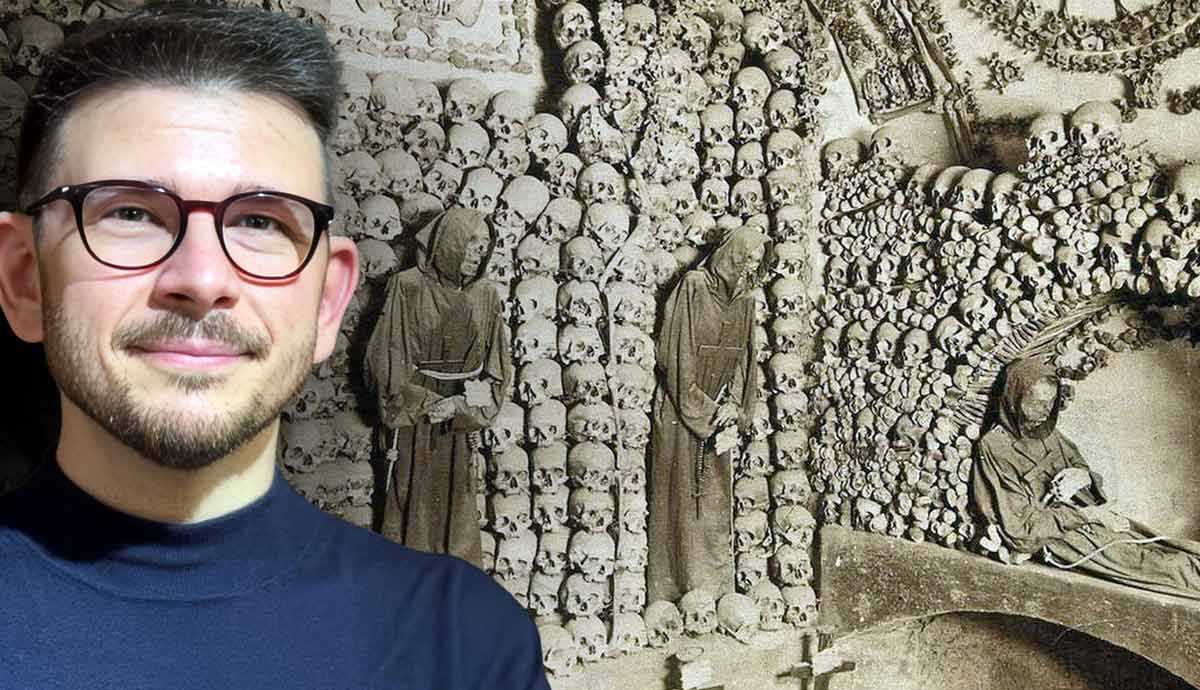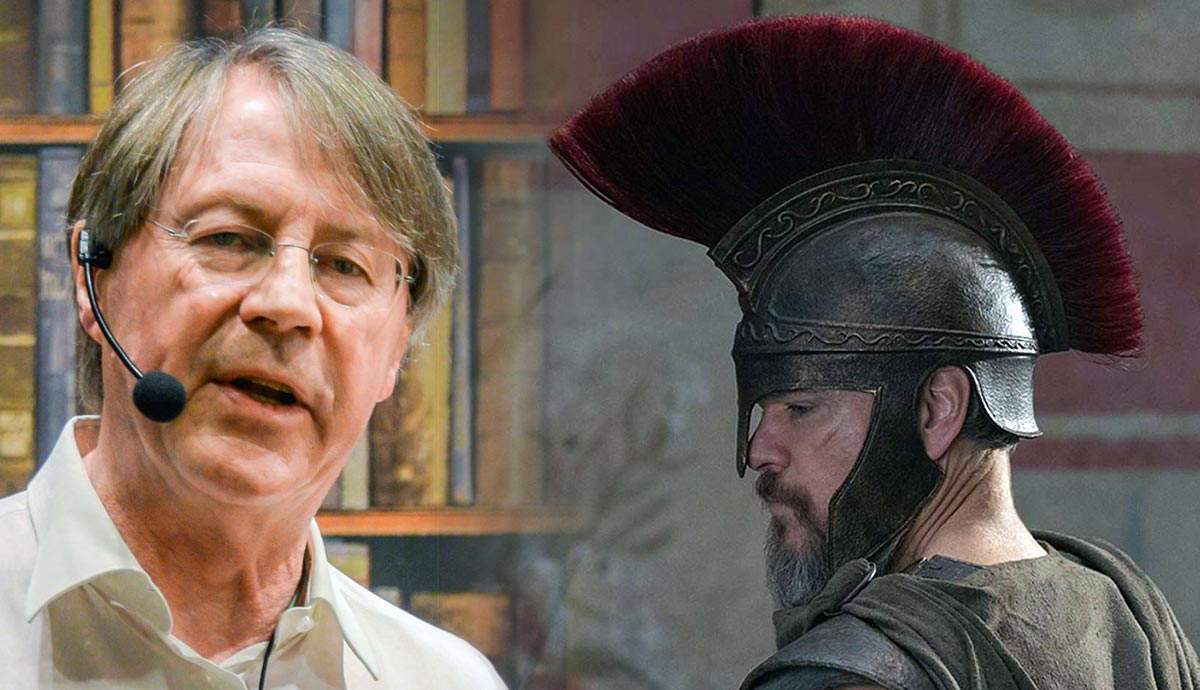
The Church of Santa Maria della Concezione dei Cappuccini (Capuchins) is one of the most fascinating in Rome, and is best known for its incredible crypt. The underground crypt holds the remains of Capuchin monks, crafted into symbolic works of art. The site has fascinated visitors for centuries, including the Marquis de Sade, who wrote about it in his diary in 1775. “I have never seen anything more striking.” The crypts also inspired Nathaniel Hawthorne’s The Marble Faun (1860) and Mark Twain’s Innocents Abroad (1869). Today, we learn more about the crypt and Richard Marranca interviews its director, Pietro Costantini, revealing little-known secrets.
Pietro Costantini has a Ph.D. from the University of Teramo, for which he wrote his thesis about the Capuchin Friars between the 16th and 18th centuries. He has served as Director of the Museum and Crypt of the Capuchins in Rome since September 2024. A fuller profile of Pietro is included at the bottom of this article.
Discovering the Capuchin Crypt

Richard Marranca (RM): So, the crypt, of course, is below your Church of Santa Maria. It’s on the Via Veneto near Piazza Berberini. By the way, the Via Veneto was featured in scenes of the classic movie La Dolce Vita. You are just around the corner from the Fountain of Trevi and Vatican City. What’s it like being in one of the world’s centers?
Pietro Costanini (PC): Being located in such an iconic place as Via Veneto, near Piazza Barberini, is an extraordinary privilege. Our church, with its unique crypt, is not only a historical and spiritual landmark but also a site that harmoniously fits into one of the most captivating areas of Rome. Being close to landmarks like the Trevi Fountain and just a few kilometers from Vatican City allows us to welcome visitors from all over the world, drawn by the beauty of the Eternal City and the profound spiritual message that our complex represents.
Via Veneto is a place where history, culture, and spirituality converge. This makes our environment even more special. It is an oasis of reflection amidst the dynamism of one of Rome’s most famous streets. Being here means safeguarding a spiritual and artistic treasure that continues to inspire and captivate all who visit.
Famous Visitors Over the Centuries

RM: The crypt has had many notable visitors over the centuries, such as Mark Twain, Oscar Wilde, and so many others. Marquis de Sade wrote, “I have never seen something so striking.” Why all the fascination?
PC: The crypt captivates with its uniqueness and the profound message it conveys. The decorations made with the bones of friars and benefactors are not only an extraordinary work of art but also a powerful reminder of the fragility and transience of human life. The inscription, “What you are now, we once were; what we are now, you shall be,” invites visitors to reflect on the meaning of life and death in a way that few other places can.
This combination of aesthetics, spirituality, and existential reflection is what has captured the imagination of notable figures and continues to profoundly impact anyone who visits this unique site. The crypt is not merely a tourist attraction but an emotional and spiritual experience that leaves an indelible impression.
A Sacred Space for the Capuchin Monks

RM: Can you tell us how the crypt is used by monks and visitors for sacred experiences?
PC: The crypt is a sacred place, conceived not only as a memorial but also as a space for prayer and reflection. For the friars, it represents an environment where they can meditate on the mystery of life and death and honor the deceased friars who preceded them in the Order. This aligns with Capuchin spirituality, which encourages living with humility and awareness of the transience of earthly existence.
Every year, on November 2nd, during All Souls’ Day, the friars celebrate Holy Mass in the crypt. This rite is a particularly meaningful moment, dedicated to praying for the souls of the departed and renewing the remembrance of their journey in the Christian faith.
For visitors, too, the crypt offers a unique opportunity for a spiritual experience. Beyond its beauty and symbolism, it invites personal reflection and connection with the mystery of eternity. Many find in this place an occasion for introspection and prayer, drawing inspiration from the universal message it conveys.
How Was the Crypt Created?

RM: Can you tell us about Fr. Michael of Bergamo? And was the soil in the crypt really brought from Jerusalem by order of Pope Urban VII? Can you tell us about the Capuchin Monks?
PC: Father Michael of Bergamo was the architect entrusted with designing the church and friary of the Capuchins on Via Veneto, completed in 1631. In addition to constructing the buildings, he also designed the crypt below, intended to serve as a burial place for the friars in accordance with Capuchin regulations, which prohibited burials inside the churches.
Regarding the soil in the crypt, there is a tradition suggesting it was brought from Jerusalem by order of Pope Urban VII. However, there is no documentary evidence to confirm this story, adding an element of fascination and mystery to this unique site. The Capuchin Friars, a branch of the Order of Friars Minor founded by St. Francis of Assisi, are known for their simplicity, humility, and closeness to the poor. Their brown habit with the characteristic hood, from which the name “Capuchins” is derived, and their life devoted to prayer and service, embody the Franciscan spirit.
The Macabre Art of the Crypt

RM: Can you tell us some of the basics? How many bodies? What was the process? How did they come to be placed in the crypt?
PC: The crypt holds the bones of approximately 3,700 deceased individuals buried between 1631 and 1870. The remains also include those from the previous Capuchin convent near the Trevi Fountain, which were transferred to the new complex designed by Father Michael of Bergamo. The burials adhered to the Capuchin rule, requiring an underground cemetery separate from the main church.
Due to limited space and the high number of friars being buried, periodic exhumations were carried out to make room for new burials. The bones were then arranged artistically, creating decorations and symbols that now adorn the six chapels of the crypt. The idea of using the bones to create a unique work of art seems to have emerged around the mid-18th century, with the artistic arrangement completed, at least partially, by 1764.
Chapel of the Three Skeletons

RM: Can you tell us a few of the special features of the crypts, such as the center skeleton in the Crypt of the Three Skeletons?
PC: The Chapel of the Three Skeletons is one of the most evocative spaces in the crypt. At its center, a small skeleton, possibly that of Princess Anna Barberini, is enclosed in an oval halo, symbolizing life. In its right hand, it holds a scythe, a symbol of death that comes to all, while in its left hand, it holds a scale, representing God’s judgment after death. Surrounding this figure are crosses made of sacral bones, floral decorations composed of clavicles and vertebrae, and rosettes crafted from jawbones, creating a unique work of art that invites reflection on the mystery of life and death.
This crypt also features three children’s skeletons, placed as a reminder that death knows no age. The remains of Capuchin friars dressed in their characteristic habits complete the scene, delivering a profound spiritual message in line with Christian and Franciscan tradition.
Other Incredible Chapels

RM: Can you share some of the special features of the other chapels?
PC: The Crypt of the Skulls is characterized by decorations made with skulls and long bones.
Three skeletons of Capuchin friars stand upright in niches. The tympanum of the central niche features an hourglass with scapula wings, symbolizing the fleeting nature of time and the urgency of living a virtuous life.
In the Crypt of the Pelvises, the entire back wall is decorated with pelvises and other bones arranged to form a large canopy. The friars rest peacefully in niches adorned with floral motifs made from bones, showcasing how artistic beauty can emerge even from mortal remains.
The Mass Chapel is the only area without bones, reserved for the celebration of Mass for the dead. Above the altar is a painting depicting Mary with the Child and the souls in Purgatory being freed from the flames. It is a place of meditation and prayer.
The Crypt of the Resurrection is decorated with bones forming arches and rosettes. It includes a painting of the resurrection of Lazarus, a symbol of Christian hope in eternal life.
Profile: Pietro Costantini, Director of the Museum and Crypt of the Capuchins in Rome

Pietro Costantini graduated with honors from the University of Teramo, with a thesis on the Venetian painter Jacobello del Fiore, under the supervision of Professor Raffaella Morselli. He holds a Ph.D. in “Historical Studies from the Middle Ages to the Contemporary Age” from the same university, with a dissertation in early modern art history focused on the cultural policies of the Capuchin Friars in Abruzzo between the 16th and 18th centuries.
He is currently a research fellow within the PRIN 2022 project “Margaret of Austria and the Courts of L’Aquila, Cittaducale, and Ortona.” He conducts various seminar activities complementary to modern art history courses and training programs for teachers of all levels on the use of digital technologies in artistic and museum research and promotion.
In 2018, he was an adjunct professor for the “Digital Humanities” workshop at the University of Teramo, and in 2019 for the course “Artistic, Cultural, Museum, and Archaeological Heritage” as part of the R.E.A.L.S.T.A.R.T. project. In 2020, he was a research fellow at the Venanzo Crocetti Foundation in Rome.
From 2021 to 2023, he was a member of the research group for the European project “Virtual Reality Science Tour” (VRSciT), in partnership with institutions and universities in Spain, Portugal, and Lithuania.
Since 2022, he has been adjunct faculty in Modern Art History at the University of Teramo, and since 2023, he has been an associate member of the inter-university research center METArte, focused on technological innovation in art historical, museographic research, and heritage diagnostics.
Since 2024, he has been a member of the Research Unit “Cultural, Religious, and Political Exchanges and Connections (16th-21st Centuries),” coordinated by Professor Massimo Carlo Giannini. Since September 2024, he has served as Director of the Museum and Crypt of the Capuchins in Rome.
He is an adjunct professor for the workshop “Smart Heritage: New Technologies for Cultural Heritage” at the University of Teramo and, from the same year, adjunct faculty in Modern Art History at Sapienza University of Rome.










